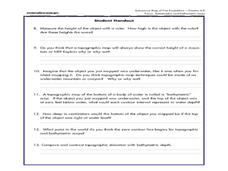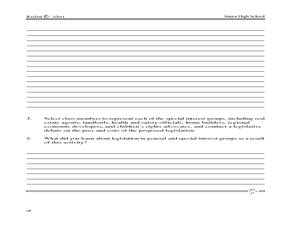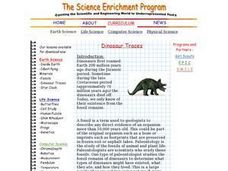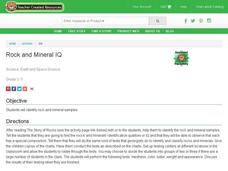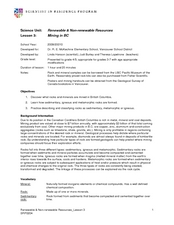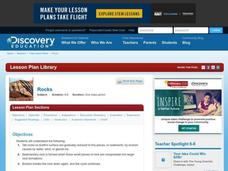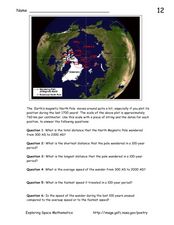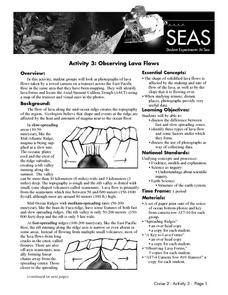Curated OER
Earthquakes: Learn From the Past, Prepare for the Future
Students examine the destruction caused by earthquakes. In this community safety lesson, students examine the risk involved in living in an earthquake zone and how to prepare for future earthquakes.
Curated OER
The Rock and Fossil Record-Science Puzzlers, Twisters & Teasers
In this earth science worksheet, students complete 12 questions about rocks and fossils in the form of anagrams, riddles, sequences, and brain teasers.
Curated OER
Sedimentation in the Grand Canyon
In this sedimentation worksheet, learners use the current rate of sediment deposit by the Colorado River in the Grand Canyon to answer questions about the changes taking place in the canyon. They graph the amount of deposit over 75 years...
Curated OER
Our Changing View of the Earth
Students explore the theory of Plate Tectonics. They participate in a simulation in which they re-enact the debate over Plate Tectonics vs. traditional beliefs of stationary continents that were widely accepted during the 1800's and...
Curated OER
Mount Everest
Young scholars brainstorm about what different professions roles are and what skills they obtain. In this critical thinking lesson, students discuss reasons of why different people would want and need to climb Mount...
Curated OER
A Watered-Down Topographic Map
Eighth graders explore the ocean floor. In this topography activity, 8th graders compare topographical maps to bathymetric charts. They will create a topographic map and note landmarks and other land features.
Alabama Learning Exchange
The Earth Has Many Layers
Students conduct an experiment. In this Earth's layers lesson, students learn about soil, sand and rock. They complete their own Jell-O Mountain and investigate the Earth's layers on-line.
Curated OER
What are the Ethical Considerations of Radon?
In this radon contamination worksheet, students explore the legal and ethical issues associated with radon found in indoor air of homes. Students construct a set of laws that promote fairness to all sellers, buyers and real estate agents...
Curated OER
Sequencing Time
Learners place events in sequence and assign relative times to each event. They gain an understanding of relative and numerical time and become familiar with the methods used by scientists to develop the Geologic Time Scale.
Curated OER
WebQuest Solar System Colonization Project 2000
Sixth graders complete a WebQuest to study the names and locations of the planets in the solar system. They investigate the causes of the seasons and the distance between the planets using astronomical units. They use technology to...
Curated OER
Dinosaur Traces
Students identify and interpret the type of evidence found at a typical dinosaur dig and mimic a paleontologist by taking crayon rubbings of simulated bone impressions. After the rubbings are taken, the students reconstruct the complete...
Curated OER
Rock and Mineral IQ
Students observe rock and mineral compositions. In this identification lesson, students read The Story of Rocks. Students identify rock and mineral samples by testing for hardness, color, luster, weight and appearance.
Curated OER
Renewable and Non-Renewable Resources: Mining in B.C.
Students explore energy by categorizing rocks. In this British Columbia geology lesson, students define many different vocabulary terms associated with mining such as sedimentary, igneous, and metamorphic. Students utilize sample rock...
Curated OER
Contributions of Immigrants
High schoolers identify the contributions of immigrants to America. They analyze the value of these contributions as well. They discuss how these contributions affect other's personal perspectives of immigrants.
Curated OER
The Geophysics And Cultural Aspects of the Greater Antilles
Young scholars determine location by using longitude and latitude. They measure to the minute longitude and latitude of a place and select a body of land and determine its location. They approximate time zones by using every 15...
Curated OER
Minerals and the Products of Mining
Learners plot where minerals come from and have an awareness of how mineral use makes the world interdependent. They examine how to identify some sort of mineral products they use each day.
Curated OER
Exploring for Petroleum - Modeling an Oil Reserve
Learners experiment with locating oil reserves. In this conservation activity, students use a cardboard box to create sand, rocks, and an oil reserve (water balloon). They use a probe to dig around in the box to find the oil reserve and...
Curated OER
Rocks
Middle schoolers examine how sedimentary rocks are formed. For this rock lesson students research different rock formations and different types of rock.
Curated OER
Glacial Striation Investigation
Students operate a GPS unit to investigate the direction of glacier movement. They describe the motion of glacier movement by interpreting a graph. Students explain how scientists use glacier striations to determine glacier movement.
Curated OER
Earth's Magnetic Pole
In this Earth's magnetic pole worksheet, students use a diagram showing the changes in the magnetic pole of the Earth over time. Students use the given scale of the changes to answer 6 questions about the average speed of the magnetic...
Curated OER
Urban Rocks: Investigating Stone Used for Buildings and Monuments
Students observe the rocks and stones used to build and carve monuments during a field trip.
Curated OER
Geography: Water, Water Everywhere
Young scholars discuss flooding and its causes. They view a Powerpoint presentation about floods and prevention methods. After creating a model with clay and pans, they investigate river behavior in various terrains with different...
Curated OER
One World Ocean
Students compare and contrast the properties of salt water in the oceans/seas and freshwater elsewhere on the planet. They also analyze mixing caused by currents in the ocean, including the effects of warm and cold water as well as with...
Curated OER
Observing Lava Flows
Learners examine the difference between fast and slow spreading lava flows. They identify various types of lava flow and determine the factors that cause them to form. Viewing photographs of lava flows, students working in groups,...





